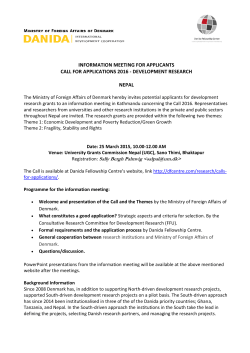
Denmark - Innovationsfonden
Denmark Economy, Education & Skills and Innovation Dr. Daniel F. Muzyka President and CEO, The Conference Board of Canada. March 2015 conferenceboard.ca Agenda • Introduction • Denmark by the numbers • Education in Denmark • Innovation in Denmark • Implications • Summary 2 1 There are three kinds of lies: lies, damned lies and statistics. Benjamin Disraeli 3 Agenda • Introduction • Denmark by the numbers • Education in Denmark • Innovation in Denmark • Implications • Summary 4 2 Denmark’s Real GDP Growth per cent change 4.0 3.0 2.0 1.0 0.0 -1.0 Denmark is in slow gear like most of the developed world but is doing better than many of its neighbours -2.0 -3.0 -4.0 -5.0 -6.0 -7.0 07 08 09 10 11 12 13 14 15f 16f Source: IMF. 5 6 3 7 Denmark’s Inflation per cent 4.0 3.0 2.0 1.0 0.0 07 08 09 10 11 12 13 14 15f 16f Source: IMF 8 4 Denmark’s Unemployment Rate per cent 8.0 7.0 6.0 5.0 4.0 3.0 07 08 09 10 11 12 13 14 15f 16f Source: IMF. 9 Denmark’s Debt gross debt as a share of GDP 50.0 45.0 40.0 35.0 30.0 25.0 20.0 07 08 09 10 11 12 13 14 15f 16f Source: IMF. 10 5 Denmark’s Fiscal Position billions of krone 70.0 60.0 50.0 The Krone will continue to be under pressure, particularly if the country takes action for long-term success 40.0 30.0 20.0 10.0 0.0 -10.0 -20.0 -30.0 -40.0 07 08 09 10 11 12 13 14 15f 16f Source: IMF. 11 World Real GDP Growth per cent change 4.0 3.0 2.0 1.0 0.0 15f 13 14f 11 12 09 2010 08 07 06 05 04 03 02 01 99 2000 98 97 96 95 94 93 92 -2.0 1991 -1.0 Source: Consensus Economics 12 6 Denmark’s Export Markets per cent of total 14 12 10 8 Denmark needs to continue to diversify its export markets into higher growth areas of the world 6 4 2 0 Japan Italy China Norway US UK Germany Sweden Source: MIT. 13 2014 World Economic Forum Global Competitiveness 14 7 DENMARK’s Overall Competitiveness Ranking, 2014: 15th (2013: 14th) Denmark (17th) Denmark (9th) • Labour market efficiency Denmark (13th) • Health and primary education (25) • Institutions (16) • Infrastructure (21) • Macroeconomic environment (16) (12) • Financial markets (27) • Market size (54) • Goods market efficiency (23) • Higher Ed. & training (10) • Technological readiness (6) Efficiency Enhancers for Competitiveness • Innovation (11) • Business sophist. (11) Innovation and Business Sophistication Factors for Competitiveness Basic Requirements for Competitiveness 15 Source: The World Economic Forum, Global Competitiveness Report 2014-2015 DENMARK: Most problematic factors for doing business (2014) Source: The World Economic Forum, Global Competitiveness Report 2014-2015 16 8 Denmark’s Agenda • Denmark is a successful nation • The country has entered a period of slow growth • Denmark is better positioned than some • Its key resource is its people and what they can do • Education, skills and innovation are key assets 17 Agenda • Introduction • Denmark by the numbers • Education in Denmark • Innovation in Denmark • Implications • Summary 18 9 Education & Skills Report Card • • • Overall, Denmark scores a “D” and ranks 13th among 16 peer OECD countries. Education & Skills indicators distinguish between three levels of attainment: K-12, post-secondary education, and adults and work. Results • Denmark ranks low on students’ skills indicators (reading, math, and science). • Scores “B” grades on university attainment and share of PhD graduates. • “C” grade performer on share of science, math, computer science, and engineering graduates. • Adult skills: relatively high share of adults with highlevel numeracy and problem-solving skills. Ranks poorly on adult literacy skills. 19 20 10 Student Performance Category High-Level Inadequate Reading skills D (16/16) C (13/16) Mathematics skills D (13/16) C (10/16) Science skills D (15/16) C (13/16) 21 22 11 23 24 12 Adult Performance Category High-Level Inadequate D (12/15) C (10/15) Numeracy skills A (7/15) B (7/15) Problem-solving skills B (7/14) C (8/14) Literacy skills 25 Denmark Education • The older generation is doing relatively well • The next generation appears to have opportunities for improvement • An increased emphasis on science and math may be one of those opportunities Denmark is competitive in education but has some opportunities for improvement 26 13 Agenda • Introduction • Denmark by the numbers • Education in Denmark • Innovation in Denmark • Implications • Summary 27 What is innovation? Innovation Value Chain Discovery Development Application Social and Economic Impact Extension Technologies Products Business Concepts Solutions Value Ideas 28 14 Innovation Report Card A’s B’s C’s D’s 1. Switzerland 4. Denmark 8. Ireland 11. Germany 2. Sweden 5. Netherlands 9. Japan 12. Australia 3. US 6. UK 10. France 13. Canada 7. Finland 14. Norway 15. Austria 16. Belgium 29 Innovation Report Card • • • Overall, Denmark scores a “B” grade and ranks 4th among 16 peer OECD countries. Innovation framework includes indicators that examine the creation, diffusion, and transformation of ideas. Results • Well-connected: scores an “A” on connectivity (broadband and fixed wireless). • Denmark ranks relatively high on R&D spending (public and business) and ICT investment, but scores “C” on venture capital investment. • Also scores “C” grades on patents, trademarks, new firm density, knowledge-based services, and medium- and high-tech manufacturing. • Poorest performance is on export market share indicators (electronics, aerospace, pharmaceuticals, and instruments) – scale issue. 30 15 Denmark Innovation Report Card The A’s 31 Sources: The Conference Board of Canada; OECD. 32 16 Sources: The Conference Board of Canada; OECD. 33 Sources: The Conference Board of Canada; OECD. 34 17 Denmark Innovation Report Card The B’s 35 Sources: The Conference Board of Canada; National Science Board. 36 18 Sources: The Conference Board of Canada; OECD. 37 Sources: The Conference Board of Canada; OECD. 38 19 Sources: The Conference Board of Canada; OECD. 39 Denmark Innovation The C’s 40 20 Sources: The Conference Board of Canada; OECD. 41 Sources: The Conference Board of Canada; OECD. 42 21 Sources: The Conference Board of Canada; OECD. 43 Sources: The Conference Board of Canada; OECD. 44 22 Sources: The Conference Board of Canada; World Bank. 45 Sources: The Conference Board of Canada; OECD. 46 23 Sources: The Conference Board of Canada; OECD. 47 Denmark Innovation • Investment in innovation is largely there • Ease of entrepreneurship and supports in place • Issues of scale and industry diversity • Risk capital an issue • Denmark is positioned relatively well: spirit willing 48 24 Agenda • Introduction • Denmark by the numbers • Education in Denmark • Innovation in Denmark • Implications • Summary 49 Lessons from innovative eco-systems • Desire • Initiative • Training • Coordination • Investment • Communication • Rewards 50 25 Lessons from innovative organisations • Focus: growth, renewal and opportunity • Leadership and culture: promoting, nurturing and protecting • Innovation management: sourcing and developing • Support: knowledge, communications and resources • Organisational agility: changing and reconfiguring • Measurement and selection: metrics and evaluation 51 Agenda • Introduction • Denmark by the numbers • Education in Denmark • Innovation in Denmark • Implications • Summary 52 26 Bottom Line • Denmark needs to maintain speed and maybe “kick it up” a gear • A shared ambition may be helpful in some areas • Some further investment in education may be in order 53 Bottom Line • Persistent demand of and support for innovation is required • Continued corporate focus on innovation and value creation is in order • Each of you needs to continue your contribution Denmark is relatively well positioned for the future but more demands are coming: complacency is any wealthy country’s worst enemy 54 27 conferenceboard.ca 28
© Copyright 2025









